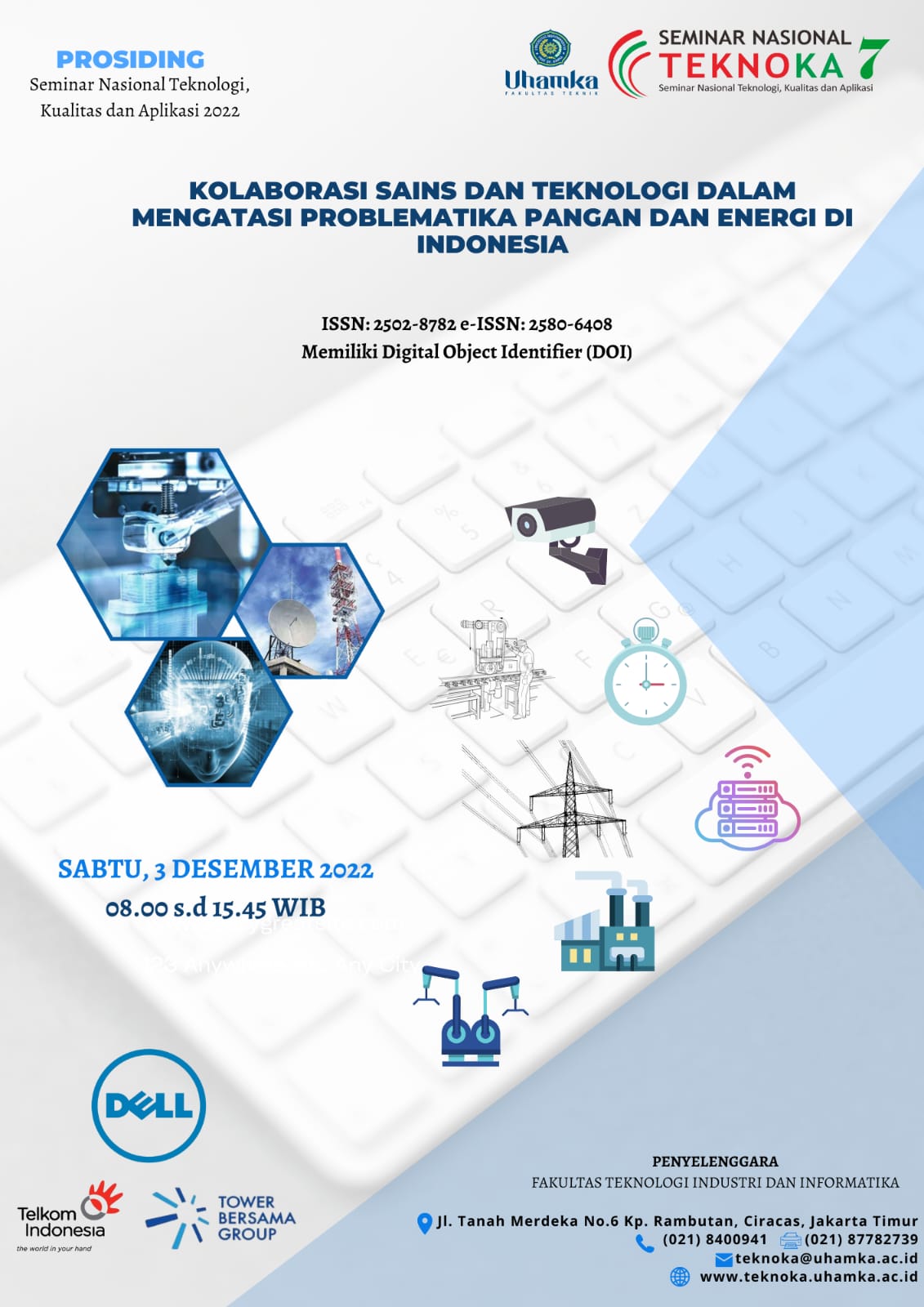Sistem Pendingin Bertenaga Surya pada Model Ruang Pendingin
Abstract
Energi surya masih menjadi harapan besar dalam menggantikan energi fosil, karena potensinya, kemudahan dalam memperolehnya serta ramah terhadap lingkungan. Konversi energi surya menjadi energi termal atau energi listrik bukan akhir dari pemanfaatan energi surya dalam kehidupan. Dengan media dua konverter energi yakni sel surya dan termoelektrik energi surya dapat dimanfaatkan untuk membuat sistem pendingin ruang. Model ruang pendingin dapat dibuat dari kotak sederhana sampai ruangan dalam bangunan. Adapun yang ingin dicapai penelitian ini untuk mendapatkan sebanyak mungkin penyerapan kalor dari ruang di bawahnya dan mendapatkan temperatur terendah. Metode yang digunakan dalam penelitian ini adalah eksperimental. Pada model ruang pendingin bagian atasnya ditempatkan sel surya dan termoelektrik yang diberi ruang pembuangan panas dari termoelektrik. Susunan sistem pendingin terdiri dari pendingin termoelektrik dan heatsink sebagai penyerap kalor. Penelitian ini menghasilkan capaian kinerja model ruang pendingin dengan nilai CoP sebesar 0,989. Sementara temperatur terendah yang dicapai oleh model ruang pendingin sebesar 25,60 oC.
Downloads
References
N. Kannan and D. Vakeesan, “Solar Energy for Future World: - A Review,” Renew. Sustain. Energy Rev., vol. 62, pp. 1092–1105,2016, doi: 10.1016/j.rser.2016.05.022.
P. G. V. Sampaio and M. O. A. González, “Photovoltaic Solar Energy: Conceptual Framework,” Renew. Sustain. Energy Rev., vol.74, no. February, pp. 590–601, 2017, doi: 10.1016/j.rser.2017.02.081.
Rifky and Y. S. Gaos, “Pengembangan Model Pendingin Kabin City Car Bertenaga Surya Menggunakan Photovoltaics (PV) dan Thermoelectric (TEC),” Teknobiz, vol. 10, no.1, pp. 34–40, 2020.
Z. Şen, “Solar Energy in Progress and Future Research Trends,” Prog. Energy Combust. Sci., vol. 30, no. 4, pp. 367–416, 2004, doi: 10.1016/j.pecs.2004.02.004.
S. A. Kalogirou, Solar Thermal Collectors and Applications, vol. 30, no. 3. 2004. doi: 10.1016/j.pecs.2004.02.001.
A. Wahab, A. Hassan, M. A. Qasim, H. M. Ali, H. Babar, and M. U. Sajid, “Solar Energy Systems – Potential of Nanofluids,” J. Mol. Liq., vol. 289, 2019, doi: 10.1016/j.molliq.2019.111049.
E. Biyik et al., “A Key Review of Building Integrated Photovoltaic (BIPV) Systems,” Eng. Sci. Technol. an Int. J., vol. 20, no. 3,pp. 833–858, 2017, doi: 10.1016/j.jestch.2017.01.009.
A. G. Lupu, V. M. Homutescu, D. T. Balanescu, and A. Popescu, “A Review of Solar Photovoltaic Systems Cooling
tKechnologies,” IOP Conf. Ser. Mater. Sci. Eng., vol. 444, no. 8, 2018, doi: 10.1088/1757-899X/444/8/082016.
M. B. Hayat, D. Ali, K. C. Monyake, L. Alagha, and N. Ahmed, “Solar Energy—A Look into Power Generation, Challenges, and A SolarPowered Future,” Int. J. Energy Res.,vol. 43, no. 3, pp. 1049–1067, 2019, doi: 10.1002/er.4252.
M. A. Contreras and S. Deb, “Solar Energy overview,” in Fundamentals of Materials for Energy and Environmental Sustainability, D. S. Ginley and D. Cahen, Eds. Cambridge: Cambridge University Press, 2012, pp. 206–215.
S. K. Sansaniwal, V. Sharma, and J. Mathur, “Energy and Exergy Analyses of Various Typical Solar Energy Applications: A
Comprehensive Review,” Renew. Sustain. Energy Rev., vol. 82, no. May, pp. 1576– 1601, 2018, doi: 10.1016/j.rser.2017.07.003.
R. Alicki, D. Gelbwaser-Klimovsky, and A. Jenkins, “A Thermodynamic Cycle for The Solar Cell,” Ann. Phys. (N. Y)., vol. 378, pp. 71–87, 2017, doi: 10.1016/j.aop.2017.01.003.
S. Suherman, A. R. Sunarno, S. Hasan, and R. Harahap, “Water and Heat-sink Cooling System for Increasing The Solar Cell Performances,” EAI Endorsed Trans. Energy Web, vol. 7, no. 26, pp. 1–10, 2020, doi: 10.4108//eai.13-7-2018.161050.
C. G. Popovici, S. V. Hudişteanu, T. D. Mateescu, and N. C. Cherecheş, “Efficiency Improvement of Photovoltaic Panels by Using Air Cooled Heat Sinks,” Energy Procedia, vol. 85, no. November 2015, pp. 425–432,2016, doi: 10.1016/j.egypro.2015.12.223.
A. Shukla, K. Kant, A. Sharma, and P. H. Biwole, “Cooling Methodologies of Photovoltaic Module for Enhancing Electrical
efficiency: A review,” Sol. Energy Mater. Sol. Cells, vol. 160, no. October 2016, pp. 275– 286, 2017, doi: 10.1016/j.solmat.2016.10.047.
A. Montecucco, J. Siviter, and A. R. Knox, “The Effect of Temperature Mismatch on Thermoelectric Generators Electrically
Connected in Series and Parallel,” Appl.Energy, vol. 123, pp. 47–54, 2014, doi: 10.1016/j.apenergy.2014.02.030.
C. J. Chen, Physics of Solar Energy. 2011. doi: 10.1002/9781118172841.
J. Patel, M. Patel, J. Patel, and H. Modi, “Improvement in The COP of Thermoelectric Cooler,” Improv. COP Thermoelectr. Cool., vol. 5, no. 5, pp. 73–76, 2015.
N. Aimable, “for Waste Heat Recovery in Local Process Industry,” Des. Model. Fabr. Thermoelectr. Gener., 2017.
A. K. Mainil, A. Aziz, and M. Akmal, “Portable Thermoelectric Cooler Box Performance with Variation of Input Power and Cooling Load,” Aceh Int. J. Sci. Technol.,vol. 7, no. 2, pp. 85–92, 2018, doi: 10.13170/aijst.7.2.8722.
A. Varghese, A. Achankunju, R. Mathew, and R. George, “Design and Fabrication of Thermoelectric Refrigerator with Thermosiphon System,” Int. J. Sci. Eng. Appl. Sci., no. 24, pp. 2395–3470, 2016, [Online]. Available: www.ijseas.com
S. Armstrong and W. G. Hurley, “A Thermal Model for Photovoltaic Panels Under Varying Atmospheric Conditions,” Appl. Therm. Eng., vol. 30, no. 11–12, pp. 1488–1495, 2010, doi: 10.1016/j.applthermaleng.2010.03.012.
J. T. Jarman, E. E. Khalil, and E. Khalaf,“Energy Analyses of ThermoelectricRenewable Energy
Sources,” Open J. Energy Effic., vol. 02, no. 04, pp. 143–153, 2013, doi: 10.4236/ojee.2013.24019.
I. Nandhakumar, N. M. White, and S. Beeby, Thermoelectric Materials and Devices. Cambridge: The Royal Society of Chemistry, 2017.
H. Lee, Heat Sinks, Thermoelectrics, Heat Pipes, Compact Heat Exchangers , and SolarCells. New Jersey: John Wiley & Sons, 2010.
Downloads
Published
How to Cite
Issue
Section
License
Copyright (c) 2023 Prosiding Seminar Nasional Teknoka

This work is licensed under a Creative Commons Attribution-NonCommercial-ShareAlike 4.0 International License.






 Supported by :
Supported by :



